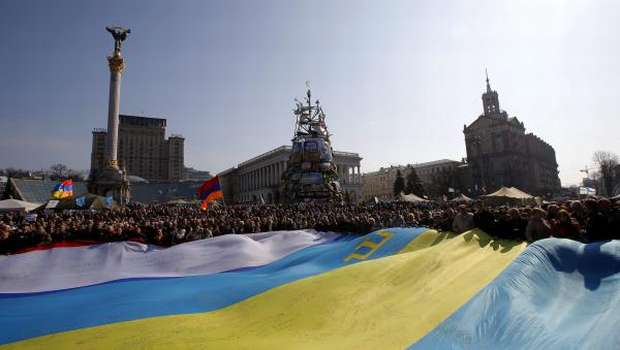
Ukrainians hold a giant composite flag, made of national, Crimean Tatars and Crimean flags, during a rally on Independence Square in Kiev, Ukraine, 23 March 2014. (EPA/Robert Ghement)
NATO’s Supreme Allied Commander Europe, US Air Force General Philip Breedlove, voiced concern about Moscow using a tactic of snap military exercises to prepare its forces for possible rapid incursions into a neighboring state, as it had done in the case of Ukraine’s Crimea region.
Russia launched a new military exercise, involving 8,500 artillerymen, near Ukraine’s border 10 days ago.
Breedlove said the Russian tactic should lead the 28-nation Western military alliance to rethink the positioning and readiness of its forces in eastern Europe so that they were ready to counter Moscow’s moves.
“A snap exercise puts an incredible force at a border. The force that is at the Ukrainian border now to the east is very, very sizable and very, very ready,” he said, speaking at an event held by the German Marshall Fund, a think tank.
“You cannot defend against that if you are not there to defend against it. So I think we need to think about our allies, the positioning of our forces in the alliance and the readiness of those forces…such that we can be there to defend against it if required, especially in the Baltics and other places.”
Ukraine is not a NATO member, but Moscow’s intervention in Crimea has caused alarm particularly in ex-Soviet republics in the Baltics, which are now members of NATO.
NATO had tried to make Russia a partner but “now it is very clear that Russia is acting much more like an adversary than a partner,” Breedlove said.
He voiced concern that Russia could have Transdniestria in its sights after Crimea, saying that, in Russia’s view, the separatist region of Moldova was the “next place where Russian-speaking people may need to be incorporated.”
Some of the elements of the Crimea scenario are also present in Transdniestria, which lies on Ukraine’s western border but is just a few hundred kilometers from Crimea.
“There is absolutely sufficient [Russian] force postured on the eastern border of Ukraine to run to Transdniestria if the decision was made to do that and that is very worrisome,” Breedlove said.
In Moscow, Deputy Defence Minister Anatoly Antonov said Russia was complying with international troop limits near the border with Ukraine, and international inspectors had conducted missions in the last month to check on Russian troop movements.
“We have nothing to hide there,” Antonov was quoted by the state RIA and Itar-Tass news agencies as saying.
The Russian-speakers of Transdniestria seceded from Moldova in 1990, a year before the dissolution of the Soviet Union, amid fears that Moldova would shortly merge with neighboring Romania, whose language and culture it broadly shares.
The separatist region fought a brief war with Moldova in 1992 and it declared itself an independent state, but it remains unrecognized by any country, including Russia.
Russia has 440 peacekeepers in Transdniestria plus other soldiers guarding Soviet-era arms stocks.
The speaker of Transdniestria’s separatist parliament urged Russia last week to incorporate the region. In response, the president of ex-Soviet Moldova warned Russia against considering any move to annex Transdniestria.
Ukraine’s Foreign Minister Andrii Deshchytsia told the Brussels conference on Friday that Transdniestria should be a big concern for Europe as well as Ukraine and Moldova because of the risk Moscow could seek to link up pro-Russian regions in Ukraine, Moldova and Georgia.
If Russia decided to connect Transdniestria with the Crimea and Georgia’s Abkhazia region, it would make a corridor that would create a “very destabilizing zone in Europe”, he said.
Breedlove said Russia appeared to be using these so-called “frozen conflicts” in neighboring countries as a tool to stop them joining the European Union and NATO.
“If Russia is worried about a country moving towards the West, the way to solve that is an incursion, a frozen conflict, and now no one wants to think about bringing that nation aboard into NATO because it might mean conflict with Russia,” he said.
US officials have said the Pentagon will more than double the number of US fighter jets on a NATO air patrol mission in the Baltics and do more training with Poland’s air force as it strives to reassure allies alarmed by the crisis in Ukraine.
Breedlove said the United States was considering other steps but declined to give details.
He said Russia’s incursion into Crimea had run “very much like clockwork” in contrast to its 2008 intervention in Georgia, which suffered from a lot of military failings.
Russia started by cutting Ukrainian forces in Crimea from their commanders using cable cuts, jamming and cyber attacks and then surrounded them, he said.
Breedlove said Russia tried to create doubts over the identity of gunmen in Crimea as part of a disinformation campaign. Moscow officially denied deploying extra troops and Russian soldiers in the region wore unmarked uniforms.
When military bases in Crimea were taken over, it was “a thin veneer of locals in the front and a lot of men in green [Russian troops] right behind,” he said.
